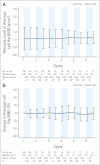Long-term dynamics of bone mineral density during intermittent androgen deprivation for men with nonmetastatic, hormone-sensitive prostate cancer
- PMID: 22493411
- PMCID: PMC3383183
- DOI: 10.1200/JCO.2011.38.3745
Long-term dynamics of bone mineral density during intermittent androgen deprivation for men with nonmetastatic, hormone-sensitive prostate cancer
Abstract
Purpose: To investigate changes in bone mineral density (BMD) and fracture risk in men who received intermittent androgen deprivation (IAD) for nonmetastatic, hormone-sensitive prostate cancer.
Patients and methods: Men with prostate cancer who lacked radiographically detectable metastases were treated in a prospective trial of IAD. After 9 months of treatment with leuprolide and flutamide, androgen deprivation therapy (ADT) was stopped until prostate-specific antigen reached a threshold (1 ng/mL for radical prostatectomy; 4 ng/mL for radiation or primary ADT) for a new cycle. Dual-energy x-ray absorptiometry (DXA) scans were performed before starting ADT and subsequently with each change in therapy. At least two consecutive DXA scans were required for this analysis. Computed tomography, bone scintigraphy, and lumbar spine x-rays were performed at the beginning and end of each treatment period.
Results: Fifty-six of 100 patients met criteria for this analysis. The median age at study entry was 64.5 years (range, 49.8 to 80.9 years). The average percentage change in BMD during the first on-treatment period was -3.4% (P < .001) for the spine and -1.2% (P = .001) for the left hip. During the first off-treatment period (median, 37.4 weeks; range, 13.4 weeks to 8.7+ years), BMD recovery at the spine was significant, with an average percentage change of +1.4% (P = .002). Subsequent periods had heterogeneous changes of BMD without significant average changes. After a median of 5.5 years (range, 1.1 to 13.8+) years on trial, one patient (1.8%) had a compression fracture associated with trauma.
Conclusion: Patients experienced the greatest average change in BMD during early treatment periods of IAD with a smaller average change thereafter. Fractures were rare.
Conflict of interest statement
Authors' disclosures of potential conflicts of interest and author contributions are found at the end of this article.
Figures





Similar articles
-
The effect of combined androgen blockade on bone turnover and bone mineral densities in men treated for prostate carcinoma: longitudinal evaluation and response to intermittent cyclic etidronate therapy.Cancer. 1998 Oct 15;83(8):1561-6. Cancer. 1998. PMID: 9781950
-
A phase 3, double-blind, randomised, parallel-group, placebo-controlled study of oral weekly alendronate for the prevention of androgen deprivation bone loss in nonmetastatic prostate cancer: the Cancer and Osteoporosis Research with Alendronate and Leuprolide (CORAL) study.Eur Urol. 2013 May;63(5):927-35. doi: 10.1016/j.eururo.2012.09.007. Epub 2012 Sep 11. Eur Urol. 2013. PMID: 23040208 Clinical Trial.
-
Duration of first off-treatment interval is prognostic for time to castration resistance and death in men with biochemical relapse of prostate cancer treated on a prospective trial of intermittent androgen deprivation.J Clin Oncol. 2010 Jun 1;28(16):2668-73. doi: 10.1200/JCO.2009.25.1330. Epub 2010 Apr 26. J Clin Oncol. 2010. PMID: 20421544 Free PMC article. Clinical Trial.
-
Intermittent androgen-deprivation therapy in prostate cancer: a critical review focused on phase 3 trials.Eur Urol. 2013 Nov;64(5):722-30. doi: 10.1016/j.eururo.2013.04.020. Epub 2013 Apr 19. Eur Urol. 2013. PMID: 23628492 Review.
-
Bone and metabolic health in patients with non-metastatic prostate cancer who are receiving androgen deprivation therapy.Med J Aust. 2011 Mar 21;194(6):301-6. doi: 10.5694/j.1326-5377.2011.tb02979.x. Med J Aust. 2011. PMID: 21426285 Review.
Cited by
-
Personalizing Androgen Suppression for Prostate Cancer Using Mathematical Modeling.Sci Rep. 2018 Feb 8;8(1):2673. doi: 10.1038/s41598-018-20788-1. Sci Rep. 2018. PMID: 29422657 Free PMC article.
-
Osteoporosis and cancer.Curr Osteoporos Rep. 2013 Sep;11(3):163-70. doi: 10.1007/s11914-013-0154-3. Curr Osteoporos Rep. 2013. PMID: 23877475 Free PMC article. Review.
-
Effect of Androgen Deprivation Therapy on Bone Mineral Density in a Prostate Cancer Cohort in New Zealand: A Pilot Study.Clin Med Insights Oncol. 2017 Oct 9;11:1179554917733449. doi: 10.1177/1179554917733449. eCollection 2017. Clin Med Insights Oncol. 2017. PMID: 29051709 Free PMC article.
-
PRESTO: A Phase III, Open-Label Study of Intensification of Androgen Blockade in Patients With High-Risk Biochemically Relapsed Castration-Sensitive Prostate Cancer (AFT-19).J Clin Oncol. 2024 Apr 1;42(10):1114-1123. doi: 10.1200/JCO.23.01157. Epub 2024 Jan 23. J Clin Oncol. 2024. PMID: 38261983 Free PMC article. Clinical Trial.
-
Risks of Serious Toxicities from Intermittent versus Continuous Androgen Deprivation Therapy for Advanced Prostate Cancer: A Population Based Study.J Urol. 2017 May;197(5):1251-1257. doi: 10.1016/j.juro.2016.12.022. Epub 2016 Dec 16. J Urol. 2017. PMID: 27993663 Free PMC article.
References
-
- Heidenreich A, Aus G, Bolla M, et al. EAU guidelines on prostate cancer. Eur Urol. 2008;53:68–80. - PubMed
-
- Loblaw DA, Virgo KS, Nam R, et al. Initial hormonal management of androgen-sensitive metastatic, recurrent, or progressive prostate cancer: 2006 update of an American Society of Clinical Oncology practice guideline. J Clin Oncol. 2007;25:1596–1605. - PubMed
-
- Messing EM, Manola J, Yao J, et al. Immediate versus deferred androgen deprivation treatment in patients with node-positive prostate cancer after radical prostatectomy and pelvic lymphadenectomy. Lancet Oncol. 2006;7:472–479. - PubMed
-
- Shahinian VB, Kuo YF, Freeman JL, et al. Increasing use of gonadotropin-releasing hormone agonists for the treatment of localized prostate carcinoma. Cancer. 2005;103:1615–1624. - PubMed
-
- Bolla M. Adjuvant hormonal treatment with radiotherapy for locally advanced prostate cancer. Eur Urol. 1999;35(suppl 1):23–25. discussion 26. - PubMed
Publication types
MeSH terms
Substances
Grants and funding
LinkOut - more resources
Full Text Sources
Medical
Miscellaneous

